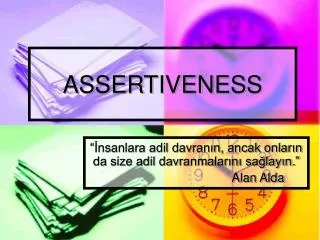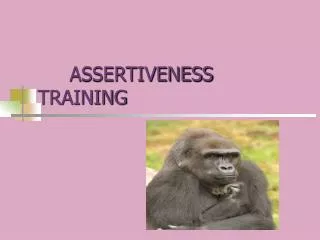
ASSERTIVENESS. Assertive behavior: Way of communication that allows individuals to express themselves ( directly, honestly, and appropriately ) with respecting other person’s right. Honestly and straight-forward expression of how we feel (to ourselves and others).

inari + Follow
Download PresentationAn Image/Link below is provided (as is) to download presentation Download Policy: Content on the Website is provided to you AS IS for your information and personal use and may not be sold / licensed / shared on other websites without getting consent from its author. Content is provided to you AS IS for your information and personal use only. Download presentation by click this link. While downloading, if for some reason you are not able to download a presentation, the publisher may have deleted the file from their server. During download, if you can't get a presentation, the file might be deleted by the publisher.

Assertiveness. Confirming confidently, positively. To defend one’s rights or opinions, sometimes with unnecessary zeal. Chambers Dictionary Expressing opinions or desires strongly and with confidence so that people take notice. Oxford Advanced Learners Dictionary. Assertiveness .
1.49k views • 15 slides

Assertiveness Training. What is an assertive personality?. You are assertive when you stand up for your rights in such a way that the rights of others are not violated Implies that you can express your personal likes and interests You can talk about yourself without being self-conscious
718 views • 11 slides

Assertiveness 101:. Intro to Saying What You Mean and Meaning What You Say. Three Patterns of Communication. Aggressive Nonassertive (Passive) Assertive. Aggressive Behavior.
883 views • 19 slides

ASSERTIVENESS . WHAT IS IT? HOW CAN IT HELP ME? WHAT DO I NEED TO DO?. ASSERTIVENESS. Assertiveness is the ability to communicate your needs, feelings, opinions, and beliefs in an open and honest manner without violating the rights of others. ASSERTIVENESS.
487 views • 11 slides

Assertiveness. Dr Ian Harris. Learning Outcomes. What is Assertiveness Recognising Behaviours Why should you be more assertive Understanding Beliefs, Rights and Responsibilities How to be more assertive. Agenda/Contents. Assertiveness: an Introduction
1.53k views • 80 slides

assertiveness. assertive. bullying self-centred insensitive. placating one-down defeated. authentic courageous fair. door mat. sledge hammer. you’re OK I’m not OK. I’m OK you’re OK. I’m OK you’re not OK.
468 views • 1 slides

ASSERTIVENESS . SIMPLE TECHNIQUE TO MAKE PEOPLE WORK FOR US AND GET THINGS DONE THROUGH THEM . TO GET THINGS DONE. WITHOUT HURTING OTHERS’ FEELINGS AND/OR FETCHING HARM TO THEM. TO OUR BENEFIT. WE MUST BE ASSERTIVE. AS PER Prof. ROOSHI KUMAR PANDYA. ASSERTIVENESS SKILL IS….
635 views • 29 slides

558 views • 40 slides

ASSERTIVENESS. “İnsanlara adil davranın, ancak onların da size adil davranmalarını sağlayın.” Alan Alda. 1-HISTORY OF ASSERTIVENESS. Socrates Smith-1975 Today. 2-WHAT IS ASSERTIVENESS?.
1.27k views • 37 slides

High. Accommodating. Problem-solver. Co-operation. Compromising. Avoidance. Win/Lose. Low. Assertiveness. High. Avoidance. Non-confrontational Ignores the conflict Denies the conflict Says “whatever” Not invested in the outcome. Accommodating. Agreeable Unassertive
313 views • 9 slides

Assertiveness . Training by Kaori & Hisashi. What is ASSERTIVENESS?. ASSERTIVENESS is…. The art of saying “NO” T he ability to communicate one's own thoughts , opinions and wishes in a clear , direct and non-aggressive way. 3 KINDS of COMMMUNCATORS. PASSIVE…. Passive
504 views • 15 slides

Assertiveness. Dr Louise Livesey, Programme Co-ordinator, MA Women’s Studies, Ruskin College Oxford 18 th April 2014. Structure of the Morning. 9am – welcome and opening exercises 9.20am – What is Assertiveness? Why is it an issue? 11am – Coffee Break
419 views • 17 slides

Assertiveness. Passive/submissive Assertive Aggressive. Passive People…. Get stepped on a lot. Are taken advantage of. Can’t say “no”. Talk softly – don’t stand up for their rights. Do whatever others ask – even if it’s very inconvenient. Do anything to avoid conflict.
364 views • 3 slides

Assertiveness Skills. Objective. Explain What is Assertiveness. Define Assertiveness. List the Benefits of Being Assertive. Describe the Liberation Cycle of Assertiveness. Describe the Various Behavior Patterns. Compare Passive, Assertive and Aggressive Behavior.
2.67k views • 18 slides

Assertiveness. KNR 253 Jakubowski & Lange, 1978 Much information on Internet. Assertiveness Is…. Technique you can use Technique you can teach your clients In Leisure Ability Model Social Interaction Skills Communication Skills Assertiveness Conversational Skills Active Listening
654 views • 26 slides

ASSERTIVENESS TRAINING. COMMUNICATION STYLES . Passive Aggressive Passive-aggressive Assertive. Passive Style. Try to avoid conflict and confrontation at all costs. Don’t share our true feelings, wants, and needs.
1.25k views • 20 slides

Neutral Statements – Nonescalating statement in a neutral voice That may be true and … I think we both want to solve this problem, but we may see it differently. I need some time to think about that. I don’t think that is the issue right now….
275 views • 1 slides

Assertiveness Skills. Course Objectives. Explain What is Assertiveness. Define Assertiveness. List the Benefits of Being Assertive. Describe the Liberation Cycle of Assertiveness. Describe the Various Behavior Patterns. Compare Passive, Assertive and Aggressive Behavior.
287 views • 8 slides

The Power to Get What You Want and Express What You Have. Assertiveness. Four Types of Communication:. Assertive Passive or Non-Assertive Aggressive Passive-Aggressive. 1. Assertive Communication.
699 views • 33 slides

Assertiveness. Dr. Joan Lutton Leadership Growth Seminar June 2011. Assertiveness. Assertiveness means being positive and confident about ourselves—our ideas, opinions and talents—and expressing these in the service of our values.
345 views • 20 slides

Developing Assertiveness. What is this session about?. Define passive, aggressive, & assertive behaviors Assertiveness – important life skill Handling criticism/verbal attacks in general Handling criticism/verbal attacks against your ideas Role play – group exercise Summary.
398 views • 23 slides

Assertiveness. Recap. Assertiveness Profile Quiz Using Non-Verbal strategies (body language) Neuro-linguistic strategies (positive use of language). Adults in the school or college. Managing situations : Emergencies Disciplinary situations First Aid supervision/coordination Drills
250 views • 19 slides